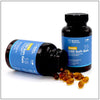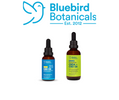Exploring the Booming CBD Craze of 2019

There’s no such thing as an overnight success in the marketing world. Every trendy product, brand, or idea comes from years of growth and formation, even if it’s happened undercover. CBD is no different. In the past several years, particularly in 2018, the CBD industry experienced massive growth in what seemed to be no time at all. Yet, the industry has actually been quietly brewing for years before now. Join Bluebird Botanicals in exploring how CBD became the craze it is today.
The old journalistic standard for reporting calls for answering six questions: who, what, when, where, why, and how. We’re going to use this approach (slightly out of order) to build a 360 perspective of where the CBD industry has been and where it’s headed next.
What is CBD?
Chances are, if you’re reading a blog about CBD market trends, you already know what CBD is. Just to provide a quick overview for context, we are specifically talking about the cannabis compound a.k.a. CBD which is derived from Cannabis sativa plants containing low levels of THC. Cannabidiol has been the subject of thousands of research studies over the past two decades due to its potential to impact and improve a lot of medical conditions and bodily processes.
CBD primarily interacts with the body’s endocannabinoid system, a grouping of millions of cannabinoid receptors found throughout your body but primarily clustered in the brain and central nervous system. While CBD is a phytocannabinoid, or plant-based cannabinoid, your body also naturally produces cannabinoids, known as endocannabinoids. Almost every organ of your body, including your skin and digestive tract, contains cannabinoid receptors.
Unlike THC, CBD does not interact strongly with the two classical cannabinoid receptors (CB1 and CB2). This is why CBD does not cause any psychoactive effect. Instead, CBD inhibits the enzymes that break down endocannabinoids, leading to an increase in your body’s naturally-produced cannabinoids. This occurs in all mammals, not just humans.
Who is using CBD?

CBD found its way to the spotlight not through trend-seeking millennials or marketing gimmicks, but largely through word-of-mouth. According to market research firm The Brightfield Group, almost half of CBD consumers discovered it through the recommendations of friends and family. Its ability to promote overall wellness has lent quite heavily to its virality.
CBD has been and continues to be enjoyed by people of all ages and genders. However, the market has found a double sweet spot with both millennials and baby boomers. According to The Brightfield Group, these two age groups have adopted CBD quite rapidly, albeit for different reasons. The 26 to 35 group, a.k.a. the “Stressed Out Millennials,” use it most prevalently to deal with emotional issues and cope with everyday stressors from work and life. The older generation of 45 to 70-year-olds on the other hand, uses it more for general well-being.
In terms of gender, hemp CBD has appealed equally to both men and women. In the U.S., it’s close to an even split - 49.1% female consumers versus 50.7% male. Interestingly, the way in which men and women use CBD is quite different, though. Men are more likely to use CBD five or more days per week, while women tend to use it only a few times per month.
Additionally, the report shows that almost 60% of American CBD consumers have (or live with) children. This indicates how CBD can be used even by families with children.
Finally, as we mentioned, it’s not just humans that are benefitting from CBD. All mammals have an endocannabinoid system, which means that CBD can benefit dogs, cats, horses, kangaroos, and anything else with vertebrae! The CBD market for pets has already started taking off as well, with items such as full-spectrum oil, soft gels, and treats now available in many online pet stores.
When did the CBD craze take off?
Cannabis has been used by humans recreationally and medicinally for thousands of years. CBD, however, wasn’t discovered until the 1940s by esteemed chemist Dr. Roger Adams and his research team at the University of Illinois. His team was the first to successfully isolate the compound, although he didn’t fully understand at the time what he had accomplished or what the properties of the isolated compound were.
Research on cannabis continued through the next two decades, and its structure was fully elucidated in 1963 by Dr. Raphael Mechoulam, often referred to as the “father of cannabis.” He was able to correctly draw out the structure of cannabidiol for the first time in history. This discovery helped develop our modern understanding of CBD and the endocannabinoid system. It also led to the eventual discovery and isolation of the other 100+ cannabinoids as well as the network of endocannabinoids including anandamide and 2-arachidonoyl glycerol (2AG).
As these scientific discoveries were occurring, cannabis experienced a blanket ban in the U.S. All forms of cannabis, even low-THC hemp, were classified as a Schedule 1 controlled substance in the 1970 Controlled Substances Act. This largely prevented most of the general public from understanding and experimenting with the potential benefits of cannabinoids until the turn of the millennium.
Hemp cultivation slowly began to open up in the U.S. in the early 2000s.
Then, in 2013, Dr. Sanjay Gupta hosted a special on CNN’s “60 Minutes” in which he explored the untapped benefits of CBD. Afterward, it quickly began rising in popularity as more and more people discovered its ability to treat a wide range of conditions.
The 2014 Farm Bill made some big waves by allowing hemp production through state-funded research programs. This was eventually followed by the 2018 Farm Bill which fully federally legalized industrial hemp for the first time in over 40 years.
With that, the CBD industry is expected to continue its meteoric growth. According to the Brightfield Group, the hemp CBD industry hit $591 million in 2018 and is expected to grow nearly 40 times that size by 2022 with a five-year compound annual growth rate of 132% percent. For comparison, the dietary supplement industry’s projected five-year CAGR is 6.9%. Natural and specialty brick-and-mortar stores represented about 14% of the $190 million in U.S. hemp-based CBD sales in 2017. CBD products now have the distinction of being a consumer product sold in the biggest variety of sales channels in the history of commerce. Sales were up more than 300% in the natural and specialty retail store channel in 2017 ($25 million) and over 100% in 2018 ($60 million).
Where is CBD most popular?

The global cannabis market is expected to reach $31.4 billion by 2021, a CAGR of 60%.
Cannabis legalization, particularly medical cannabis, has been progressing rapidly over the past several years as it becomes increasingly accepted worldwide that the plant has medicinal value. There will very soon be a full-fledged global cannabis marketplace. According to The Brightfield Group, cannabis products with low THC and high CBD are the most widely accepted globally, and imports of these products are being legalized in developed and developing markets alike.
Within the U.S., there’s a clear divide between the more cannabis-friendly western states and the more conservative midwestern, southern, and eastern states. Western states like California, Oregon, Washington, and Colorado, which have already legalized recreational and medicinal cannabis, tend to view CBD as a wellness or lifestyle product that can be picked up casually. In contrast, in regions with limited or no access to cannabis, CBD has gained popularity as a legal alternative, with consumers often showing greater interest in higher concentration CBD products and purchasing them more frequently.
Why has the CBD industry grown so much?
The short answer is because consumers have found that it works, and there’s a dearth of research to support it. From a bigger picture, it’s also in line with the general wellness trend that continue to drive consumer demand, which major manufacturers and retailers are extremely eager to capitalize on.
The U.S. CBD industry has experienced great success as a grassroots movement. Even with extreme limitations in advertising, investing, partnering, and distributing, the industry grew 57% from 2017 to 2018. This is largely in part thanks to the variety of industry association and grassroots organizations that have supported the growth of the industry and worked to change the stigma surrounding hemp and cannabis.
Much of this work began in the early 2000s. Vote Hemp, for example, was founded in 2000 by Dr. Bronner Cosmic Engagement Officer David Bronner, Erik Rothenberg, Eric Steenstra, Lloyd Hart and Eric Lineback with the goal of bringing back hemp farming in the U.S.










